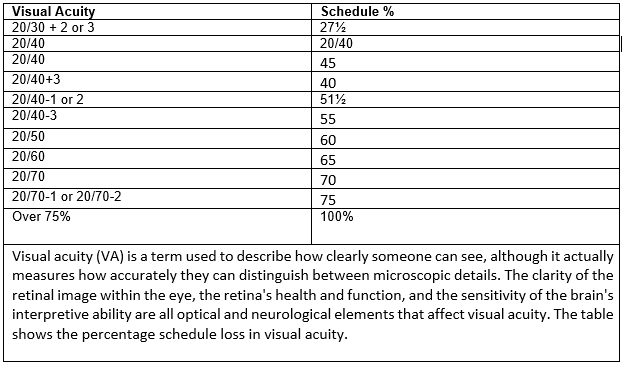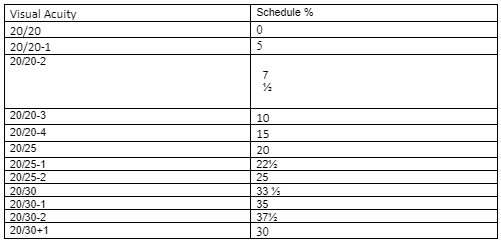Workers compensation Scheduled Loss
of Use for Visual System/Auditory System/Facial Scars
and Disfigurement
You’ve arrived to the correct location if you were injured at work and are unsure what “Scheduled Loss of Use” (SLU) implies for your Visual System/Auditory System/Facial Scars and Disfigurement.You could receive a compensation payment from the Workers’ Compensation Board if you qualify.
Our report will state that because of your work-related accident, you have lost function in the harmed body part indefinitely. Workers’ Compensation Guidelines for Determining Impairment are followed in our report. The provisions of this article are based on New York state workers compensation guidelines.
Visual System Introduction
This chapter’s goal is to offer standards for use in assessing permanent impairment brought on by dysfunction of the visual system, which includes the eyes, ocular adnexa, and visual pathways. There is a method offered for calculating visual impairment brought on by a work-related injury. A payment plan can then be created using this information.
The scheduling criteria are 🙁 1) Loss of uncorrected or corrected visual acuity for distant objects, (2) Visual field loss, and (3) Diplopia. These three functions serve as the foundation for evaluating visual impairment. Without the coordinated operation of all three, vision is flawed even though they are not equally critical.
When there is a facial or eye defect that is noticeable, this is scheduled on a case-by-case basis.
To evaluate the functions of the eye, the following tools are required:
- Distance vision visual acuity test charts; preferred charts include the Landolt’s broken-ring chart, the illiterate E chart, and the Snellen test chart with letters and numbers.
- A perimeter of the Goldmann type or an automated perimeter where the degree of the visual field is measured.
- Refraction instruments, recent refraction reports, or reports of recently prescribed glasses.
- A red-glassed hand-held light.
- The slit lamp.
- An ophthalmoscope.
Criteria and Methods for Evaluating Permanent Impairment
Central Visual Acuity
It should not be filthy or stained on the chart or reflecting surface. The far test distance simulates infinity at a minimum of 4 m. and a maximum of 6 m (13 ft. 1 in.).
When using traditional eyeglasses or not, the central vision should be measured and noted for distance.
The use of contact lenses may help eyesight that has been hampered by irregular astigmatism brought on by a disease or injury to the cornea. Correction with contact lenses is appropriate if there are no contraindications, the patient is accustomed to wearing them, and they are desired.
The distance at which the smallest letter that the patient could distinguish would subtend 5 minutes of arc, or the distance at which an eye with 20/20 vision could see that letter, should be used to calculate visual acuity for distance. This value should be expressed in feet or meters. Because it is more convenient, the fraction notation does not indicate a proportion of visual acuity.
The following steps should be followed to determine if one eye has lost its central vision:
- Determine the optimal central visual acuity for distance with and without contact lenses or conventional corrective eyewear.
Set the schedule in accordance with Table 1 for the larger of the uncorrected or corrected vision loss (in the injured eye).
Visual Loss


Loss of vision can be a very distressing occupational hazard. We rely on our sense of sight to guide us through daily life, so losing it suddenly, even if it only results in diminished vision; can be upsetting in addition to the physical difficulties it brings.
Visual Fields
A perimetric approach with a white target is used to estimate the size of the visual field. If the Goldmann bowl perimeter with a 30 cm radius is used, the III/4 e target in the kinetic mode ought to be used.
Calculating Visual Field Loss
The steps taken to determine the loss of visual field are as follows:
- Using Figure 11.2 of a visual field chart, plot the size of the visual field along each of the eight major meridian lines (a-2).
- Based on Table 11.1, calculate the percentage loss to schedule (a-3)
Example of Perimetric Charts

Note: These charts are used to plot extent or outline of visual field along the eight principal meridians, separated by 45-degree intervals.
Visual Field Loss

In addition: sum of 8 principal radii of peripheral field add up to 420. This is 100% industrial visual field efficiency. To calculate: Add 8 principal meridians of patient’s peripheral field (x)
x/420 = % Efficiency (y)
100-y% = % Loss to Schedule for Eye
Determining Schedule for Diplopia
Perform a red-glass test, chart the degree of diplopia within a 30-degree field, and calculate using Schedule loss for the wounded eye. Add the schedule for central vision loss and visual field loss in the affected eye to the percentage loss for diplopia.
Diplopia

Hearing Loss
The inner ear is highly sensitive to loud noise (cochlea). Hearing loss can result through repeated exposure to extremely loud noises or by listening to loud noises for extended periods of time. The cochlea’s cells and membranes can be harmed by loud noise. Long-term exposure to loud noise can overwork ear hair cells, which can lead to cell death.
As long as the exposure continues, the hearing loss worsens. Even after the exposure to noise has ended, negative consequences could still exist. In most cases, damage to the auditory nerve system or inner ear is irreversible.
Three months must pass after a worker quits their job or is shielded from loud noise at work before they can file a claim for a hearing loss caused by their job (can be by way of effective protective devices). The worker’s date of disablement is regarded as the final day of the three-month removal period.
Occupational Hearing Loss
Audiometric tone tests are carried out in accordance with these criteria, which in essence measure the capacity to hear speech normally, at frequency levels of 500, 1000, 2000, and 3000 Hertz (Hz).
Results are averaged across the four frequency ranges, and if the threshold at which a person can hear sound is 25 dB (decibels) or less, no hearing impairment is thought to exist.
Hearing loss is estimated to be percent for every decibel above 25 dB that an ear’s hearing level exceeds, reaching 100 % at 92 dB. The employee would have a % hearing loss in that ear if their hearing level was 41 dB.
The figure is then added to the percentage of hearing loss in the worker’s poorer ear. The percentage of hearing loss in the worker’s better ear then multiplied by 5. The result is the worker’s overall percentage of hearing loss for which benefits are paid out, which is calculated by dividing the sum by 6.
Traumatic Hearing Loss
Traumatic Hearing Loss: This condition can be brought on by a blow to the head, an intense airburst in the ear, etc.
The approach used to assess the severity of hearing loss brought on by trauma differs from that used to assess hearing loss brought on by occupational illness.
A scale based on 250 Cycles Per Second (CPS) to 4000 CPS is used to measure percentages.
The time frame for both ears to completely stop hearing is 150 weeks, while the time frame for each ear is 60 weeks. The proportion of loss in each ear is added together, totalled, and then divided by 2 to determine the loss.
For example:
25% in right ear
40% in left ear
65% total loss
Divide 65% by 2, which equal 32½ %.
Most of the time, a physical exam won’t reveal any distinct alterations. The following tests may be performed:
- Audiology/audiometry
- MRI of the brain
- A head CT scan
Facial Scars and Disfigurement
- One year after the last surgical procedure or one year after the injury, permanent scars and disfigurement of the face and neck are typically assessed.
- Scars and other neck-related disfigurement are confined to the area above the clavicle.
- Detailed information on the scar and disfigurement should be provided, including its specific location as well as its length, width, color, and contour.
- Particular mouth, nose, ear, and eye disfigurement should be noticed.
- Common eye disfigurement include corneal scarring, iris deficit, and in extreme cases, complete eye loss with the use of a prosthetic.
- Nasal septal deviation, hypertrophy, and tissue loss are typical nose disfigurements
- Common lip disfigurements include soft tissue loss, swelling, and changes to the lips’ natural contour.
- Common ear disfigurements include tissue loss and changes to the ear’s natural contour.
- The dentist’s report should be consulted if teeth are damaged.
Many industrial injuries result in scarring or disfigurement, including scars from surgeries to cure an injury. Compensation for scarring may be included in workers’ compensation; however it is not always the case. Awards were more widely accessible for many more severe past injuries.
A physician would assess the scar, no matter where it was on the person, upon the worker’s request. The physical would then determine a compensation amount for the scar based on its location, prominence, size, and other aspects. The prize would be expressed as cash over a specified period of weeks.
Please refer to the Workers Compensation Board website of your state or speak with your Workers Compensation attorney for more information.
